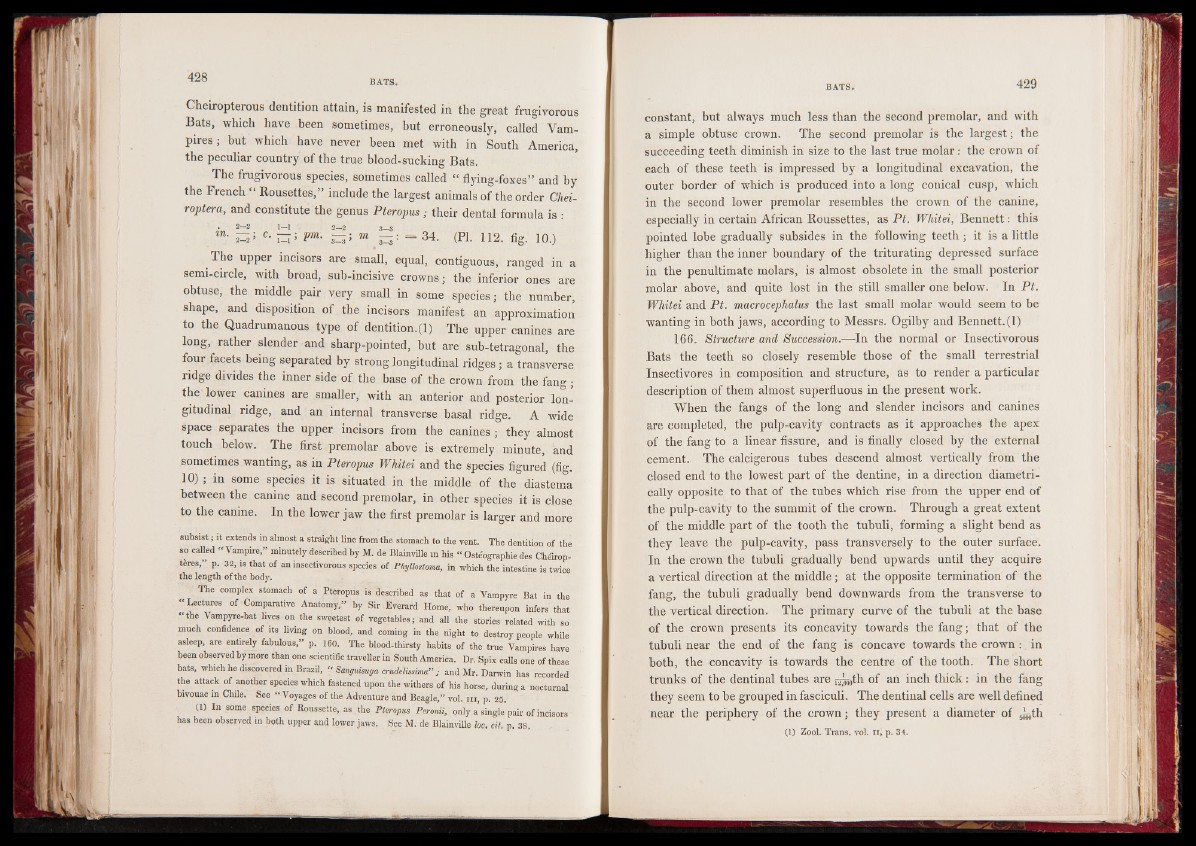
Cheiropterous dentition attain, is manifested in the great frugivorous
Bats, which have been sometimes, but erroneously, called Vampires;
but which have never been met with in South America,
the peculiar country of the true blood-sucking Bats.
The frugivorous species, sometimes called “ flying-foxes” and by
the French “ Rousettes,” include the largest animals of the order Cheiroptera,
and constitute the genus Pteropus ; their dental formula is :
1—1 2—2 3—3
pm- m m ^ = 34- (PL 112. fig. 10.)
The upper incisors are small, equal, contiguous, ranged in a
semi-circle, with broad, sub-incisive crowns; the inferior ones are
obtuse, the middle pair very small in some species; the number,
shape, and disposition of the incisors manifest an approximation
to the Quadrumanous type of dentition.(1) The upper canines are
long, rather slender and sharp-pointed, but are sub-tetragonal, the
four facets being separated by strong longitudinal ridges ; a transverse
ridge divides the inner side of the base of the crown from the fang ;
the lower canines are smaller, with an anterior and posterior longitudinal
ridge, and an internal transverse basal ridge. A wide
space separates the upper incisors from the canines ; they almost
touch below. The first premolar above is extremely minute, and
sometimes wanting, as in Pteropus Whitei and the species figured (fig.
10) ; in some species it is situated in the middle of the diastema
between the canine and second premolar, in other species it is close
to the canine. In the lower jaw the first premolar is larger and more
subsist ; it extends in almost a straight line from the stomach to the vent. The dentition of the
so called “ Vampire,” minutely described by M. de Blainville in his “ Oste'ographie des Chéiroptères,”
p. 32, is that of an insectivorous species of Phyllostoma,the length of the body. in which the intestine is twice
The complex stomach of a Pteropus is described as that of a Vampyre Bat in the
“ Lectures of Comparative Anatomy,” by Sir Everard Home, who thereupon infers that
"the Vampyre-bat lives on the sweetest of vegetables; and all the stories related with so
much confidence of its living on blood, and coming in the night to destroy people while
asleep, are entirely fabulous,” p. 160. The blood-thirsty habits of the true Vampires have
been observed by more than one scientific traveller in South America. Dr. Spix calls one of these
bats, which he discovered in Brazil, “ Sanguisuga crudelissima” ; and Mr. Darwin has recorded
the attack of another species which fastened upon the withers of his horse, during a nocturnal
bivouac in Chile. See “ Voyages of the Adventure and Beagle,” vol. in, p. 25.
(1) In some species of Roussette, as the Pteropus Peronii, only a single pair of incisors
has been observed in both upper and lower jaws. See M. de Blainville loc. cit. p. 38.
constant, but always much less than the second premolar, and with
a simple obtuse crown. The second premolar is the largest; the
succeeding teeth diminish in size to the last true molar: the crown of
each of these teeth is impressed by a longitudinal excavation, the
outer border of which is produced into a long conical cusp, which
in the second lower premolar resembles the crown of the canine,
especially in certain African Roussettes, as Pt. Whitei, Bennett: this
pointed lobe gradually subsides in the following teeth ; it is a little
higher than the inner boundary of the triturating depressed surface
in the penultimate molars, is almost obsolete in the small posterior
molar above, and quite lost in the still smaller one below. In Pt.
Whitei and Pt. macrocephalus the last small molar would seem to be
wanting in both jaws, according to Messrs. Ogilby and Bennett. (1)
166. Structure and Succession.—In the normal or Insectivorous
Bats the teeth so closely resemble those of the small terrestrial
Insectivores in composition and structure, as to render a particular
description of them almost superfluous in the present work.
When the fangs of the long and slender incisors and canines
are completed, the pulp-cavity contracts as it approaches the apex
of the fang to a linear fissure, and is finally closed by the external
cement. The calcigerous tubes descend almost vertically from the
closed end to the lowest part of the dentine, in a direction diametrically
opposite to that of the tubes which rise from the upper end of
the pulp-cavity to the summit of the crown. Through a great extent
of the middle part of the tooth the tubuli, forming a slight bend as
they leave the pulp-cavity, pass transversely to the outer surface.
In the crown the tubuli gradually bend upwards until they acquire
a vertical direction at the middle; at the opposite termination of the
fang, the tubuli gradually bend downwards from the transverse to
the vertical direction. The primary curve of the tubuli at the base
of the crown presents its concavity towards the fang; that of the
tubuli near the end of the fang is concave towards the crown : in
both, the concavity is towards the centre of the tooth. The short
trunks of the dentinal tubes are ^„th of an inch thick: in the fang
they seem to be grouped in fasciculi. The dentinal cells are well defined
near the periphery of the crown; they present a diameter of ^ th
(1) Zool. Trans, vol. ii, p. 34.